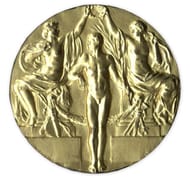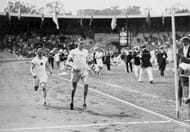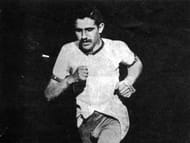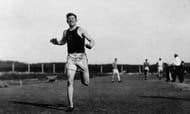Following the success of the London Olympics in 1908, the quadrennial event moved further north. For the first time, a city was elected as the host unopposed. Stockholm hosted the fifth edition in 1912.
Like other editions, this one also saw its share of firsts. For the first time, the races were electronically timed. The Stockholm Olympics saw the introduction of a fully automatic timing system developed by Ragnar Carlstedt. Under the system, the timer would be triggered once the starter's pistol was fired, and stopped manually by a timing official allocated for each runner. The system also included a photo of the winner as they crossed the finish line.
These Games also saw the official debut of an Asian team in the form of Japan. When Norman Pritchard made his debut in the Paris Olympics for India, he did it as an individual.
Oscar Swahn, hero of the London Olympics, returned to his native country with a bang. He won a gold medal in the 100m running deer and bronze in the double-shot 100 meter running deer competition. The Grand Old Man of the Games graced the stage one last time at the Antwerp Olympics in 1920 and took home a silver medal.
The grueling rules of the marathon took their toll on participants. A Japanese athlete fell unconscious while Portuguese marathoner Francisco Lazaro died of extreme fatigue and perspiration, becoming the only athlete to die during an Olympic marathon.
The event also underscored the conflict between amateurism and professionalism. American athlete Jim Thorpe became a sensation for winning both the pentathlon and the decathlon. However, his medals were confiscated because it was learnt that he had violated the amateurism rules by playing two seasons of semi-professional baseball before competing in the Olympics. It took 70 years for the International Olympic Committee to realize the error in their ways and restore Thorpe's medals.
Here are some more interesting facts about the Stockholm Olympics of 1912:
First Standard Olympics
![Stockholm Olympics - The first Standard Olympics [Image for Representational Purposes]](https://staticg.sportskeeda.com/editor/2021/07/83009-16252945386161-800.jpg?w=190)
If the London Olympics had brought about a standardization of rules, the Stockholm Games brought about a standardization of the schedule. For the first time, a standard time frame was laid down and the entire event was conducted within a fortnight.
The opening ceremony of the Stockholm Olympics was conducted on July 6, 1912 and by July 22, the event was wrapped up. Since then, no Summer Olympics have stretched beyond 16-17 days.
Prior to that, the 1900 Paris Olympics had begun on May 14 and ended on October 28, while the St. Louis Olympics of 1904 ran from July 1 to November 23. The London Olympics of 1908 was the longest ever, beginning on April 27 and ending on October 31.
Last Olympics to issue solid gold medals

Stockholm 1912 was also the last 'lucky Olympics'. This was the final edition of the Games where the gold medalists received solid gold medals.
The winners of the inaugural edition of the modern Olympics in Athens 1896 received silver medals. There was no provision for medals for third-place finishers. The runners-up were not much better off either, for they received copper medals. In the Paris Olympics, winners either received cups or trophies. Some lucky winners received silver medals as well.
It was at the St. Louis Olympics in 1904 where athletes were presented with solid gold medals for coming first, and silver and bronze for second and third respectively.
The tradition eventually came to an end at the 1920 Antwerp Olympics, where it was finally decided that all the medalists would receive plated medals, not solid ones.
Official Asian Debut at Olympics -

Asia made their individual debut at the Paris Olympics in 1900. However, it was at the 1912 Olympics that an official team was sent from an Asian country.
Japan's journey to the Olympics was unique. According to Baron Pierre De Coubertin, his intention for the Olympic Games was to be global in scale. However, to his disappointment, no athletes from any Asian nation participated in the first four games, causing him considerable concern.
At that time, Kristian Hellström of the Swedish Olympic Committee wrote to the government of Japan to ask if they were going to send teams to the 1912 Olympics. The Japanese government did not want to embarrass itself on an international stage by saying no, so they directed the Ministry of Education to look into it. Moreover, Japan had attracted international attention by defeating Russia in 1905, something few had thought possible.
The Ministry turned to Kanō Jigorō, the founder of modern judo. Two athletes represented Japan in their Olympic debut. One was Yahiko Mishima, a sprinter. The other was Shizo Kanakuri, a marathoner. During the marathon, Kanakuri lost consciousness and was taken care of by a caring Swedish family. However, humiliated by his experience, he returned to Japan.
When Swedish authorities discovered his experience, they gave him another chance a few years later. He accepted and completed the marathon in 54 years, 8 months, 6 days, 5 hours, 32 minutes and 20.3 seconds, remarking, "It was a long trip. Along the way, I got married, had six children and 10 grandchildren!"
Francisco Lazaro's death -

Shizo Kanakuri was lucky but not everyone came off so fortunate. The early Olympic marathons took place under extremely grueling conditions. Following Paris 1900, conditions grew from bad to worse. During London 1908, Italy's Dorando Pietri was helped more than once by officials in reaching the finish line. As a result, he was disqualified, even though it wasn't his fault.
However, the grueling heat in Sweden took its toll on Francisco Lazaro. A Portuguese carpenter, he participated in the marathon event and died after collapsing at the 30km mark.
Initially, it was perceived that Lázaro was suffering from severe dehydration due to the high temperature registered at the time of the race. However, it was also learnt that Lázaro had covered large portions of his body with suet, a kind of meat wax, to prevent sunburn. Instead, it created an electrolyte imbalance that ended up proving fatal.
Jim Thorpe and the conflict of amateurism

Jim Thorpe, an American athlete, participated in both the classic pentathlon and the decathlon at the Sweden Olympics.
He won both events and earned a personal recommendation from the Swedish royal family. However, in 1913, it was learned that Thorpe used to play professional baseball before the Olympics and was stripped of his medals. There were strict rules regarding amateurism in those days. No professional athlete could dare compete at the Olympics.
However, Thorpe didn't know about the rules nor did he violate the 30-day clause. He received many offers from professional football teams and was reasonably successful but The Great Depression put paid to his career. He eventually passed away due to heart failure.
It took 70 whole years for the International Olympic Committee to finally realize their folly and they sought forgiveness from Thorpe's family. They also restored his medals.
